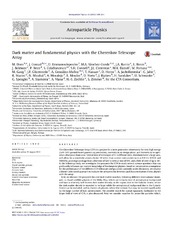Dark matter and fundamental physics with the Cherenkov Telescope Array
| dc.contributor.author | Doro, M | eng |
| dc.contributor.author | Conrad, J. | eng |
| dc.contributor.author | Emmanoulopoulos, D. | eng |
| dc.contributor.author | Sanchez-Conde, M.A. | eng |
| dc.contributor.author | Barrio, JA | eng |
| dc.contributor.author | Birsin, E. | eng |
| dc.contributor.author | Bolmont, J. | eng |
| dc.contributor.author | Brun, P. | eng |
| dc.contributor.author | Colafrancesco, S. | eng |
| dc.contributor.author | Connell, S.H. | eng |
| dc.contributor.author | Contreras, JL | eng |
| dc.contributor.author | Daniel, M.K. | eng |
| dc.contributor.author | Fornasa, M. | eng |
| dc.contributor.author | Gaug, M. | eng |
| dc.contributor.author | Glicenstein, J.F. | eng |
| dc.contributor.author | Gonzalez-Munoz, A. | eng |
| dc.contributor.author | Hassan, T | eng |
| dc.contributor.author | Horns, D. | eng |
| dc.contributor.author | Jacholkowska, A | eng |
| dc.contributor.author | Jahn, C. | eng |
| dc.contributor.author | Mazini, R | eng |
| dc.contributor.author | Mirabal, N. | eng |
| dc.contributor.author | Moralejo, A | eng |
| dc.contributor.author | Moulin, E. | eng |
| dc.contributor.author | Nieto, D | eng |
| dc.contributor.author | Ripken, J. | eng |
| dc.contributor.author | Sandaker, Heidi | eng |
| dc.contributor.author | Schwanke, U | eng |
| dc.contributor.author | Spengler, G. | eng |
| dc.contributor.author | Stamerra, A | eng |
| dc.contributor.author | Viana, A. | eng |
| dc.contributor.author | Zechlin, H.S. | eng |
| dc.contributor.author | Zimmer, S. | eng |
| dc.date.accessioned | 2015-04-13T12:31:45Z | |
| dc.date.available | 2015-04-13T12:31:45Z | |
| dc.date.issued | 2013-03 | eng |
| dc.identifier.issn | 0927-6505 | en_US |
| dc.identifier.uri | https://hdl.handle.net/1956/9774 | |
| dc.description.abstract | The Cherenkov Telescope Array (CTA) is a project for a next-generation observatory for very high energy (GeV–TeV) ground-based gamma-ray astronomy, currently in its design phase, and foreseen to be operative a few years from now. Several tens of telescopes of 2–3 different sizes, distributed over a large area, will allow for a sensitivity about a factor 10 better than current instruments such as H.E.S.S, MAGIC and VERITAS, an energy coverage from a few tens of GeV to several tens of TeV, and a field of view of up to 10°. In the following study, we investigate the prospects for CTA to study several science questions that can profoundly influence our current knowledge of fundamental physics. Based on conservative assumptions for the performance of the different CTA telescope configurations currently under discussion, we employ a Monte Carlo based approach to evaluate the prospects for detection and characterisation of new physics with the array. First, we discuss CTA prospects for cold dark matter searches, following different observational strategies: in dwarf satellite galaxies of the Milky Way, which are virtually void of astrophysical background and have a relatively well known dark matter density; in the region close to the Galactic Centre, where the dark matter density is expected to be large while the astrophysical background due to the Galactic Centre can be excluded; and in clusters of galaxies, where the intrinsic flux may be boosted significantly by the large number of halo substructures. The possible search for spatial signatures, facilitated by the larger field of view of CTA, is also discussed. Next we consider searches for axion-like particles which, besides being possible candidates for dark matter may also explain the unexpectedly low absorption by extragalactic background light of gamma-rays from very distant blazars. We establish the axion mass range CTA could probe through observation of long-lasting flares in distant sources. Simulated light-curves of flaring sources are also used to determine the sensitivity to violations of Lorentz invariance by detection of the possible delay between the arrival times of photons at different energies. Finally, we mention searches for other exotic physics with CTA. | en_US |
| dc.language.iso | eng | eng |
| dc.publisher | Elsevier | en_US |
| dc.rights | Attribution CC BY | eng |
| dc.rights.uri | http://creativecommons.org/licenses/by/3.0/ | eng |
| dc.subject | CTA | eng |
| dc.subject | Dark matter | eng |
| dc.subject | Dwarf satellite galaxies | eng |
| dc.subject | Galactic centre | eng |
| dc.subject | Galactic halo | eng |
| dc.subject | Galaxy clusters | eng |
| dc.subject | Axion-like particles | eng |
| dc.subject | Lorentz invariance violations | eng |
| dc.subject | Neutrino | eng |
| dc.subject | Magnetic monopoles | eng |
| dc.subject | Gravitational waves | eng |
| dc.title | Dark matter and fundamental physics with the Cherenkov Telescope Array | en_US |
| dc.type | Peer reviewed | |
| dc.type | Journal article | |
| dc.date.updated | 2015-04-01T08:47:32Z | en_US |
| dc.description.version | publishedVersion | en_US |
| dc.rights.holder | Copyright 2012 Elsevier B.V. | en_US |
| dc.identifier.doi | https://doi.org/10.1016/j.astropartphys.2012.08.002 | |
| dc.identifier.cristin | 1039021 | |
| dc.source.journal | Astroparticle physics | |
| dc.source.40 | 43 | |
| dc.source.pagenumber | 189-214 | |
| dc.subject.nsi | VDP::Mathematics and natural scienses: 400::Physics: 430::Astrophysics, astronomy: 438 | en_US |
| dc.subject.nsi | VDP::Matematikk og naturvitenskap: 400::Fysikk: 430::Astrofysikk, astronomi: 438 | nob |

